H12-261 : HCIE-R&S (Written) (Huawei Certified Internetwork Expert-Routing & Switching) : Part 10
-
What are the possible causes for an establishment failure of an IBGP peer relationship between two routers?
- Multi-hop IBGP is not configured.
- There is no reachable IGP route between the routers.
- Authentication fails.
- The BGP protocol versions are different.
-
The router data is as follows. Which of the following statements is true?
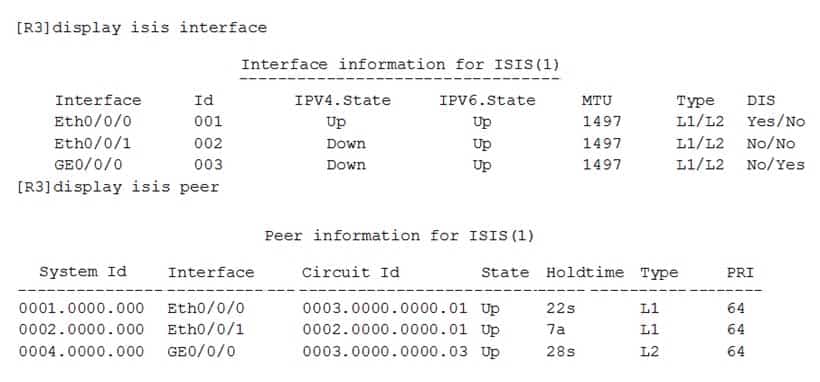
H12-261 HCIE-R&S (Written) (Huawei Certified Internetwork Expert-Routing & Switching) Part 10 Q02 032 - IS-IS IPv4 and IS-IS IPv6 are enabled on Eth0/0/1 of R3.
- Ge0/0/0 of R3 and neighbor routers are in different areas.
- R3 is the Level-1 DIS and Level-2 DIS for the link where Eth0/0/0 resides.
- The circuit-level of Eth0/0/0/1 on R3 is Level-1-2.
-
Which of the following statements regarding LSDB synchronization on an IS-IS broadcast network is true?
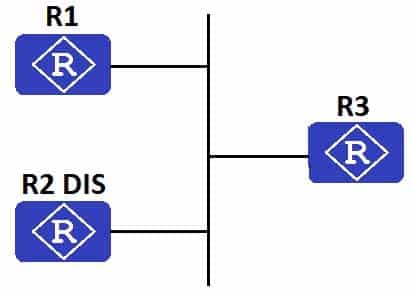
H12-261 HCIE-R&S (Written) (Huawei Certified Internetwork Expert-Routing & Switching) Part 10 Q03 033 - R2 functions as the DIS and sends Hello PDUs at an interval three times that of non-DIS routers.
- R2 functions as the DIS and does not receive PSNPs from other routers.
- R2 functions as the DIS and periodically sends CSNPs.
- R1 and R3 maintain the LSDB consistency by sending PSNPs periodically.
-
Which of the following statements regarding IS-IS authentication are true?
- After area authentication is configured on a router, IIH PDUs, SNPs, and LSPs sent by the router must carry an authentication TLV.
- Interface authentication can authenticate Level-1 and Level-2 Hello PDUs.
- After interface authentication is configured on a router, IIH PDUs sent by the router must carry an authentication TLV.
- Two routers can establish a neighbor relationship when they are configured with area authentication and interface authentication, respectively, and are configured with the same authentication password.
-
A BGP connection goes down after being successfully set up.
What is not possible cause for this problem?
- Negotiation of parameters in Open packets fails.
- Mandatory attributes in Update packets are missing.
- Error BGP packets are received.
- After the BGP connection is set up, no Keepalive packet is received within the negotiated holdtime.
-
On an OSPF broadcast network, four routers (RTA, RTB, RTC, and RTD) are deployed on the same network segment. The DR priorities of RTA, RTB, RTC, and RTD are 2, 1, 1, and 0 respectively, and router IDs are 192.168.1.1, 192.168.3.1, and 192.168.4.1 respectively.
Which router is selected as the BDR if OSPF is enabled on the four routers?
- RTC
- RTB
- RTD
- RTA
-
When a Layer 2 switch sends IP packets originating from one VLAN to another, which of the following fields is rewritten?
- Layer 3 TTL
- Layer 3 source IP address
- Layer 3 transport protocol
- Layer 2 TTL
- Layer 3 destination IP address
-
Both IS-IS CSNPs and OSPF DD packets describe the brief information about link state databases in MA network.
Which of the following statements regarding the two types of packets is true?
- After CSNPs and DD packets are received by the peer router, the peer router needs to send an acknowledgement message; otherwise, the packets need to be retransmitted.
- Once the neighbor relationship is established, CSNPs and DD packets are not sent.
- The master/slave relationship in OSPF DD packet exchange is not bound to DR/BDR; and CSNPs are generated only by the DIS.
- After CSNPs and DD packets are received by the peer router, the peer router does not need to send an acknowledgment message.
-
Which of the following address prefixes indicates that the address is a globally unique and globally routable IPv6 unicast address, similar to a public IPv4 address?
- ::1/128
- FE80::/10
- FC00::/7
- 2000::/3
-
Which of the following technologies use tunnels to allow for communication between devices with IPv6 addresses?
- ISATAP
- 6to4
- NAT64
- Dual Stack
-
Synchronization between LDP and IGP suppresses reachable IGP route advertisement to implement network convergence and ensure LDP and IGP are along the same path. This minimizes traffic loss and improves network reliability.
- TRUE
- FALSE
-
Which of the following statements regarding MPLS is false?
- MPLS supports multi-layer nesting. The value of the S bit of the innermost label is 1.
- The label space range of dynamic signaling protocols such as LDP and MP-BGP from 16 to 1023.
- When an IP packet is transmitted on an MPLS network that uses TTL processing in pipe mode, the TTL value of the IP packet decrements by 1 only at the ingress and egress nodes of the MPLS network.
- The MPLS label is 20 bits long and is used for packet forwarding.
-
The output of the display in vpn-instance verbose command for displaying detailed information about all VPN instances on a network device is as follows.
Which of the following statements are false?
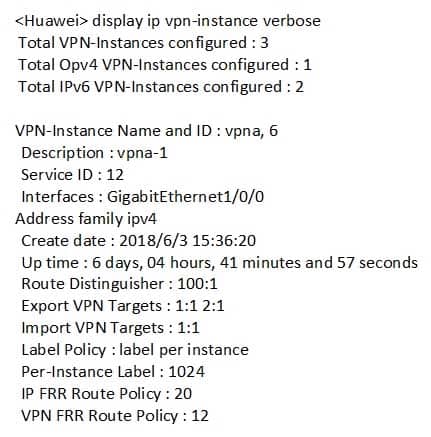
H12-261 HCIE-R&S (Written) (Huawei Certified Internetwork Expert-Routing & Switching) Part 10 Q13 034 - The device assigns a label to each route of the VPN instance vpna.
- GigabitEthernet1/0/0 is bound to the VPN instance vpna.
- The total number of locally configured VPN instances for which IPv6 address families are enabled is 1.
- The VPN instance vpna does not receive VPN routes with RT being 2:1.
-
Which of the following statements correctly describe the LDP LSP establishment process?
- When the next hop of an LSR changes due to a change in network topology and liberal mode is used, the LSR can use the previous label sent to a non-optimal next hop to quickly reestablish an LSP. Liberal mode requires more memory and label space than conservative mode.
- By default, for the same FEC, the label mapping that an LSR receives can only originate at the optimal next hop.
- In DoD label advertisement mode, an LSR can distribute labels to a specified FEC without having to receive Label Request messages from its upstream device.
- An LSP is established by binding an FEC to a label and advertising the binding relationship to the upstream LSR.
-
If multiple candidate RPs are configured in a multicast domain, which of the following parameters need to be compared when electing the RP of the group from multiple candidate RPs?
- IP address of the C-RP interface
- Mask length of the group range that is supported by the C-RP and needs to be matched with the group address joined by receivers
- C-RP interface ID
- C-RP priority
-
Network administrators can use CAR technology in traffic policing.
Which of the following technologies can be applied in CAR?
- Dual buckets at dual rates
- Single bucket at a single rate
- Three buckets at a single rate
- Dual buckets at a single rate
-
Router A has an IP route with the destination network segment of 10.0.0.1/32 and outbound interface of GigabitEthernet0/0/1. The following configuration is added:
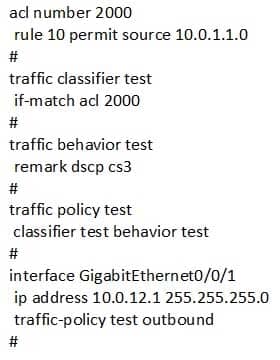
H12-261 HCIE-R&S (Written) (Huawei Certified Internetwork Expert-Routing & Switching) Part 10 Q17 035 Assume that router A receives a data packet with the destination IP address of 10.0.0.1.
Which of the following statements are true?
- If the source IP address of the data packet is 10.0.1.2, the data packet cannot be forwarded.
- If the source IP address of the data packet is 10.0.1.2, the data packet can be forwarded and the DSCP value is set to CS3.
- If the source IP address of the data packet is 10.0.1.1, the data packet can be forwarded and the DSCP value is set to CS3
- If the source IP address of the data packet is 10.0.1.2, the data packet can be forwarded and the DSCP value remains unchanged.
-
As shown in the following figure, R1 and R2 establish an EBGP peer relationship and the BFD function is enabled. Given this information, which of the following statements is true?
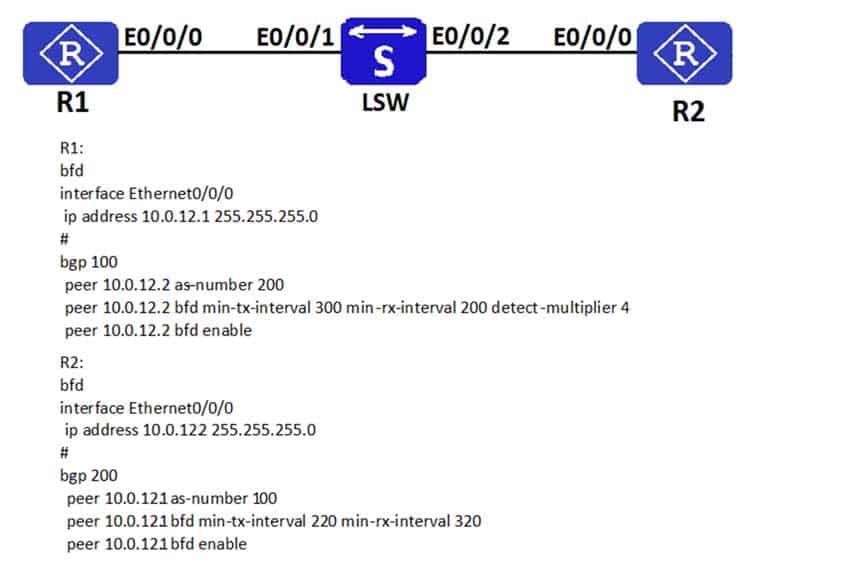
H12-261 HCIE-R&S (Written) (Huawei Certified Internetwork Expert-Routing & Switching) Part 10 Q18 036 - The time taken to detect BFD packets on R1 is 660 ms.
- The time taken to detect BFD packets on R2 is 800 ms.
- The time taken to detect BFD packets on R2 is 600 ms.
- The time taken to detect BFD packets on R1 is 1280 ms.
-
Which of the following statements regarding VXLAN packets are true?
- A VNI has 24 bits and is used to identify a VXLAN segment.
- The destination UDP port number is 4789.
- The outer destination IP address is the IP address of the remote VTEP in a VXLAN tunnel.
- The source UDP port number is 4789.
-
Which packet type is used when BGP EVPN is used to establish VXLAN tunnels?
- Type 4
- Type 1
- Type 2
- Type 5
- Type 3
Subscribe
0 Comments
Newest